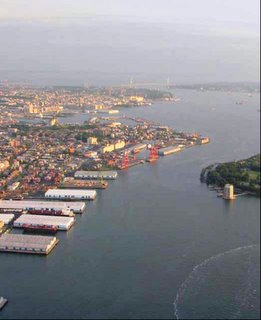On February 16, 2005 the CMRC and its partners facilitated a half-day workshop in conjunction with our Business Stewardship Initiative, an effort which brings together the resources of local industry with conservation efforts, to discuss the opportunities and constraints of creating partnerships and implementing restoration projects in the NY - NJ Harbor Estuary. The workshop attracted over 30 participants from the conservation and business communities, each of whom contributed to the workshop's panel discussions and final "working session." A synopsis of the day's activities can now be found in the Workshop Report and PowerPoint Summary, with conclusions and next steps outlined in the Executive Summary (below). One of the major recommendations of the workshop was to create a Business Stewardship Speaker Series that showcases local businesses and their coastal conservation efforts in the region. Stay tuned for more on the Speaker Series and on the Business Stewardship Initiative as we go forward! JB
CMRC Business Stewardship Workshop Summary (PowerPoint)
http://thecmrc.org/docs/BusinessStewardshipWorkshopSummary.pptCMRC Business Stewardship Workshop Report
http://thecmrc.org/docs/BusinessStewardshipWorkshopReport.docEXECUTIVE SUMMARY
On February 16, 2006 the Coastal Marine Resource Center of New York (CMRC) and its partners convened a Harbor Estuary Business Stewardship Workshop to identify focus areas and next steps for developing a Business Stewardship Program. The event was attended by thirty business and environmental leaders in the region and included a series of panel discussions that generated ideas and recommendations for developing a Businesses for the Harbor program.
Based on the findings of the workshop, the CMRC and its partners will be going forward with the following next steps towards the creation of a Businesses for the Harbor program: - Formation of a Business Stewardship Workgroup with six to eight members
- Continued outreach to stewardship programs both within and outside the Harbor
- Facilitate additional focus groups with business and conservation organizations
- Development of Businesses for the Harbor program structure and goals by 2007
The Chesapeake Bay’s Businesses for the Bay (B4B) Program shared the successes of their voluntary stewardship program during the first session. In the past decade, B4B has signed up over 700 businesses as member organizations in an effort to improve pollution prevention in the Chesapeake. In addition, nearly 140 organizations have been established as mentors that provide technical knowledge to other businesses striving to reduce the environmental impacts of their activities. A major component of the B4B Program is a well-developed reward and recognition program that provides excellent visibility for member organizations.
Businesses showcased their stewardship experiences during the second panel session and presentations from NY Water Taxi, Patagonia, the Brooklyn Navy Yard, and Credit Suisse provided insight into how different sectors approach environmental and social issues. Highlighted were the ranges of opportunities for collaboration available for stewardship in the region. While some organizations leverage human resources to implement conservation projects, others conduct pollution prevention activities upstream to reduce their environmental impact.
During the Stewardship in the Harbor Estuary session representatives from the private, non-profit, and government communities discussed their conservation efforts locally. Presentations from the New York Shipping Association (NYSA), the Hudson River Foundation – Harbor Roundtable, and EPA Performance Track showcased a variety of techniques that have achieved success by bringing together knowledge, human resources, and conservation goals. NYSA, for example, assists the maritime industry in reducing their air and water quality impacts, while the Harbor Roundtable is developing a funding strategy for restoration projects within the estuary.
Finally, participants identified and refined focus areas for developing a Business Stewardship Program during the “working session.” Participants agreed that business stewardship is an important topic and provided a great range of ideas on sectors and stewardship focus areas to be considered during program development. The general consensus was that the program needs to: offer businesses guidance on how to best use their resources to benefit conservation efforts; and, provide a visible recognition program that rewards participants as “Stewards of the Estuary.” CMRC Business Stewardship Workshop Summary (PowerPoint)
http://thecmrc.org/docs/BusinessStewardshipWorkshopSummary.pptCMRC Business Stewardship Workshop Report
http://thecmrc.org/docs/BusinessStewardshipWorkshopReport.doc
 Once dominated by 19th-century Victorian homes and mansions, the area now offers trendy housing options such as the upscale Bay Street Landing condo complex, newly constructed high-rises and Manhattan-style townhouses. Actor Paul Newman is said to have lived in the area during the mid-1960s.
Once dominated by 19th-century Victorian homes and mansions, the area now offers trendy housing options such as the upscale Bay Street Landing condo complex, newly constructed high-rises and Manhattan-style townhouses. Actor Paul Newman is said to have lived in the area during the mid-1960s.

